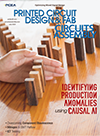Defect of the Month

Measuring BGA joints can reveal process problems.
This month we show variation in the size of the solder joints on a section of a BGA. Measuring variation on solder ball size after reflow is useful. Even better is when measurements are taken automatically with an x-ray system, as this provides a good comparison tool between NPI and production builds.
Measuring NPI build, and saving the measurement data, provides a good point of reference when problems are seen on a build. It is also useful when moving between contractors or in the event of changes due to other process modifications.

While coatings are typically used on boards, some choose to coat components as well.
This month we show manual conformal coating on one component. One optical example is shown under normal lighting and then under UV light, to show the tracer added in coatings to allow easy manual or automatic inspection. This is not a defect. I asked if this was intended, however, as it was unusual.
Traditionally, coatings are used to protect circuit boards in humid environments and more so in condensing conditions to prevent corrosion. On some occasions design engineers also use coatings to provide that little stability.
 Flux becomes increasingly tenacious the longer it sits on the board.
Flux becomes increasingly tenacious the longer it sits on the board.
This month our topic is not so much a defect as something to consider when running environmental tests before any destructive analysis on solder joints. The through-hole joints shown in FIGURES 1 and 2 were soldered with a high-temperature alloy as part of our trials on robotic laser and single point soldering. The amount of flux in high-temperature cored wire tends to be higher, hence more residues after soldering. If sample boards will be exposed to high-temperature storage, in this case 200°C for 1,000 hr., or temperature cycling, clean the residues first. It is much more difficult to clean after this level of aging, and mounting samples in epoxy for microsections is much more difficult.
 Inappropriately sized pads can result in excessive solder and, eventually, defects.
Inappropriately sized pads can result in excessive solder and, eventually, defects.
This month we show soldering of 01005 chip resistors from an early project with lead-free assembly. The microsection image in FIGURE 1 shows a few issues, but it’s the circles in both joints that caught my eye. Yes, they are voids before they are unmasked. During sectioning we stopped just before entering the void. Most would have continued a few more micros to remove the thin sliver of solder, which was the wall of the void, to show the void. But everyone has seen voids before!
 Solvents in holes can heat and "pop."
Solvents in holes can heat and "pop."
This month we look at voids or missing conformal coating. Depending on the lack of coating and position, this condition may result in acceptance or rejection. Normally with conformal coatings, small voids not specifically associated with electrical termination or bridging connections are acceptable, depending on the level of inspection criteria.
FIGURE 1 shows voids or bubbles in conformal coating under UV dark light. I would suggest both these cases require rework, as the electrical termination points are exposed, and there is no protection. Most likely, solvent coating has run into the holes. As the coating starts its first transition from a liquid, the voids expand from the holes. Then they pop, leaving the surface or pads with no protection.
It is suggested too much coating was applied on one pass, and initial evaporation could not occur, resulting in a volcano-like reaction from the holes. Each of the holes associated with coating voids had limited solder fill or cavities. In the past, we have seen the same problem with selective coating around press-fit connectors.
 A lack of compression can be seen nondestructively.
A lack of compression can be seen nondestructively.
This month we look at crimp connections.
FIGURES 1 and 2 show examples of simple compression connections. Figure 1 shows an excessive length of stripped wire within the crimp termination and a total lack of any compression, which should be easy to see on the wire bundle from the point of entry to the point of compression. Figure 2 lacks compression of the connector, and the stripped wire is barely within the barrel of the connector.
Press Releases
- SisTech Manufacturing Leads the Charge Against Electronic Component Obsolescence with Innovative Solutions
- CE3S Announces Strategic Partnership with Ideal-tek to Expand Precision Tools Offering
- Bittele Electronics’ Malaysia Facility Achieves ISO 9001:2015 Certification
- Bittele Electronics’ Malaysia Facility Achieves ISO 9001:2015 Certification


